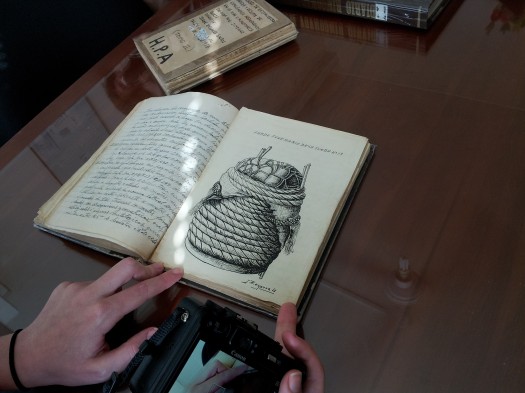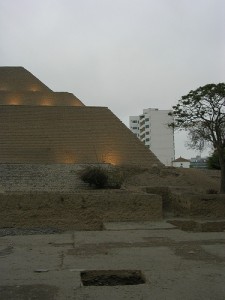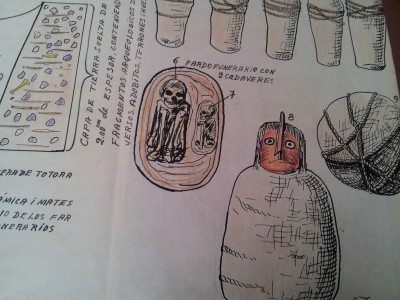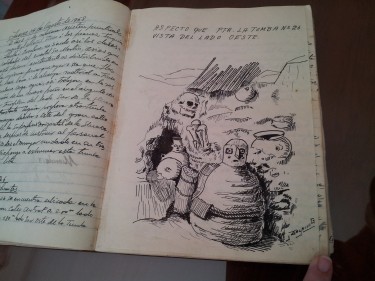 On the taxi ride there, I felt a little ill. The long, sleepless flight to Lima, a dodgy lunch that was coming back to haunt me, and the abrupt swerving and lurching of the taxi through the congested streets of the Peruvian capital—all seemed to be taking their toll. By the time I and my companions clambered out at the Puruchuco Museum and filed into a small backroom to meet the director, I was certain I was in for a long, queasy afternoon. Then I spotted two old notebooks lying on the table.
On the taxi ride there, I felt a little ill. The long, sleepless flight to Lima, a dodgy lunch that was coming back to haunt me, and the abrupt swerving and lurching of the taxi through the congested streets of the Peruvian capital—all seemed to be taking their toll. By the time I and my companions clambered out at the Puruchuco Museum and filed into a small backroom to meet the director, I was certain I was in for a long, queasy afternoon. Then I spotted two old notebooks lying on the table.
Pulled from storage for our visit, the notebooks contained handwritten field notes that a young Peruvian archaeologist and artist, Jorge Zegarra Galdos, had written nearly 60 years ago during the excavation and reconstruction of Huallamarca, an ancient pyramid and ceremonial site in one of Lima’s toniest neighborhoods, San Isidro. But it wasn’t the notes themselves that caught my attention. It was Zegarra’s pen-and-ink drawings of dozens of tombs that he and his colleagues discovered along the top of the pyramid—tombs that encased fragile fardos, human mummies wrapped in a thick cocoons of textiles.
 Huallamarca, I should explain first off, is something of an archaeological disaster. The principle investigator, a rather famous Peruvian archaeologist named Arturo Jiménez Borja, worked desperately to preserve the 2000-year-old site from Lima’s urban sprawl. But in the end, the singleminded researcher made a fatal error: he decided to reconstruct its fallen ramps and platforms so that Limeños could once again marvel at Huallamarca’s grandeur. Brick by adobe brick, he rebuilt the pyramid and the surrounding chambers, but the end result–so regular and symmetrical that it looks like a Marvel comic-book temple—bears no resemblance at all to ancient Huallamarca.
Huallamarca, I should explain first off, is something of an archaeological disaster. The principle investigator, a rather famous Peruvian archaeologist named Arturo Jiménez Borja, worked desperately to preserve the 2000-year-old site from Lima’s urban sprawl. But in the end, the singleminded researcher made a fatal error: he decided to reconstruct its fallen ramps and platforms so that Limeños could once again marvel at Huallamarca’s grandeur. Brick by adobe brick, he rebuilt the pyramid and the surrounding chambers, but the end result–so regular and symmetrical that it looks like a Marvel comic-book temple—bears no resemblance at all to ancient Huallamarca.
The story of Huallamarca had bothered me no end as I prepared for my trip to Lima. But as I thumbed through the pages of Zegarra’s field journals in the Puruchuco Museum, I experienced a small miracle. I saw the architecture and tombs of Huallamarca exactly as they had once been.
 Each summer in university field schools from Minnesota to Mongolia, archaeologists try to impress on their students the importance of keeping detailed field notes. Digging is, after all, a hideously destructive affair: you disturb and destroy data every time you edge your trowel into sediments. The only saving grace is the sharp eye of an archaeologist who diligently jots down, maps and draws details of the strata—the sediments, the charcoal specks, the stone scatter. With meticulous field notes, later generations of archaeologists can often visualize a dig layer by layer.
Each summer in university field schools from Minnesota to Mongolia, archaeologists try to impress on their students the importance of keeping detailed field notes. Digging is, after all, a hideously destructive affair: you disturb and destroy data every time you edge your trowel into sediments. The only saving grace is the sharp eye of an archaeologist who diligently jots down, maps and draws details of the strata—the sediments, the charcoal specks, the stone scatter. With meticulous field notes, later generations of archaeologists can often visualize a dig layer by layer.
 Zegarra wasn’t just a good student: he took field notes to a new level. With just a few penstrokes, he captured the conical tombs of Huallamarca and all their contents: the neatly tied bundles of totorro reeds, the musical instruments, the pots containing offerings, the wooden masks with wide-open eyes and startled expressions. They were so lifelike these drawings, that I found myself imagining young Zegarra sitting there on the roof of the pyramid, pen in hand in the warm sunlight, sketching, sketching, one tomb after another.
Zegarra wasn’t just a good student: he took field notes to a new level. With just a few penstrokes, he captured the conical tombs of Huallamarca and all their contents: the neatly tied bundles of totorro reeds, the musical instruments, the pots containing offerings, the wooden masks with wide-open eyes and startled expressions. They were so lifelike these drawings, that I found myself imagining young Zegarra sitting there on the roof of the pyramid, pen in hand in the warm sunlight, sketching, sketching, one tomb after another.
I lost myself in Zegarra’s drawings, and an afternoon that began disastrously ended as a little miracle.
Photos of the field journals of Jorge Zegarra Galdos by Heather Pringle; photo of Huallamarca, Peru by Greenery’s photostream, Flickr.
Beautiful field notes, by both archaeologist and writer.
Thanks, Cameron!
These sketches are beautiful. I wonder if such field notes are a dying breed now that people can just snap visual notes with their ever-present phones.
Fortunately, archaeologists continue to take extremely detailed field notes. Here’s a link to one field school director on the subject:
http://terrypbrock.com/2012/05/how-to-get-an-a-in-field-school/
But I don’t often see archaeologists sketching and drawing artifacts in the field anymore: the camera is ubiquitous, just as you guessed. And in some ways, that’s a shame. The very act of sketching requires that you really look at an artifact, really focus on what you are seeing. In previous eras, some of the best archaeologists were also artists: Howard Carter, the discoverer of Tutanhkamun’s tomb is a real case in point. His sketches of the tomb and its contents are incredible! One day I will blog about that.
Now that I think about it: early (pre-camera) astronomers also sketched. And of course botanists. We could have a series, The Sketches of Scientists.